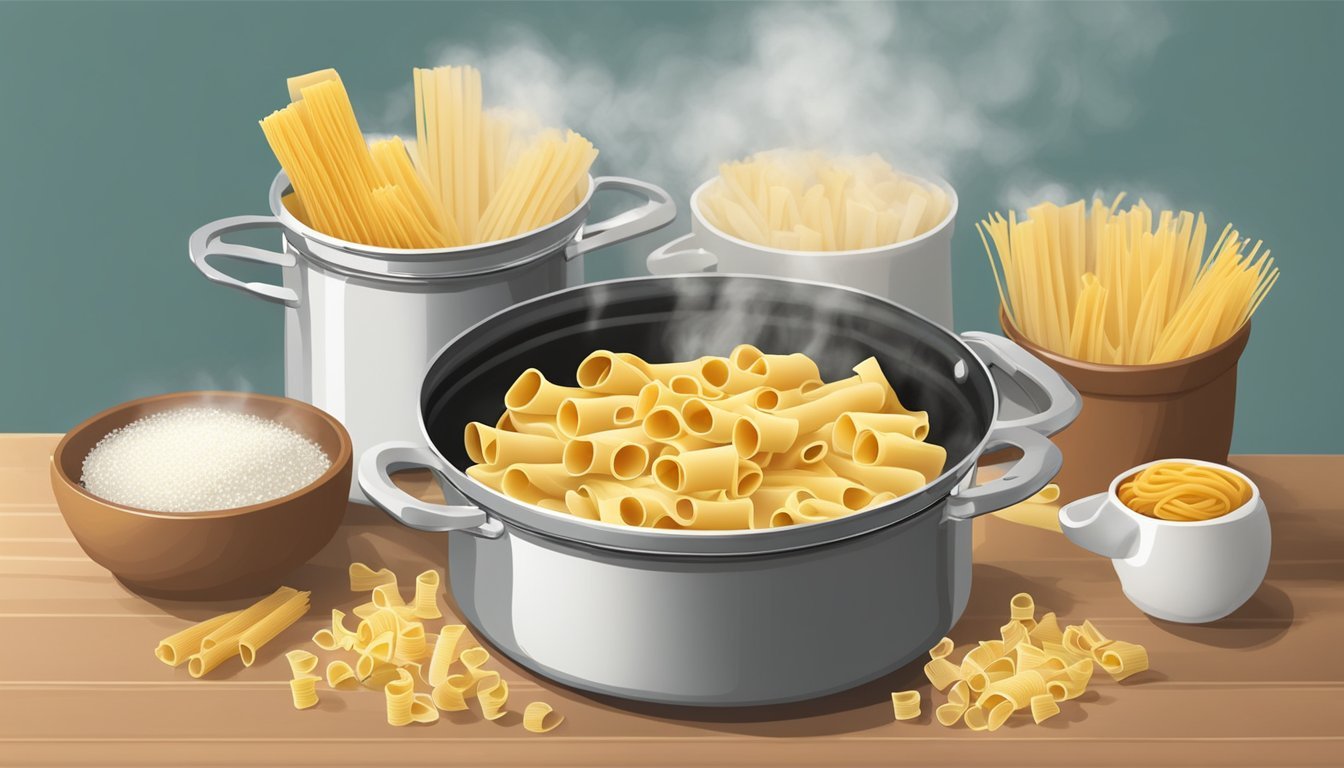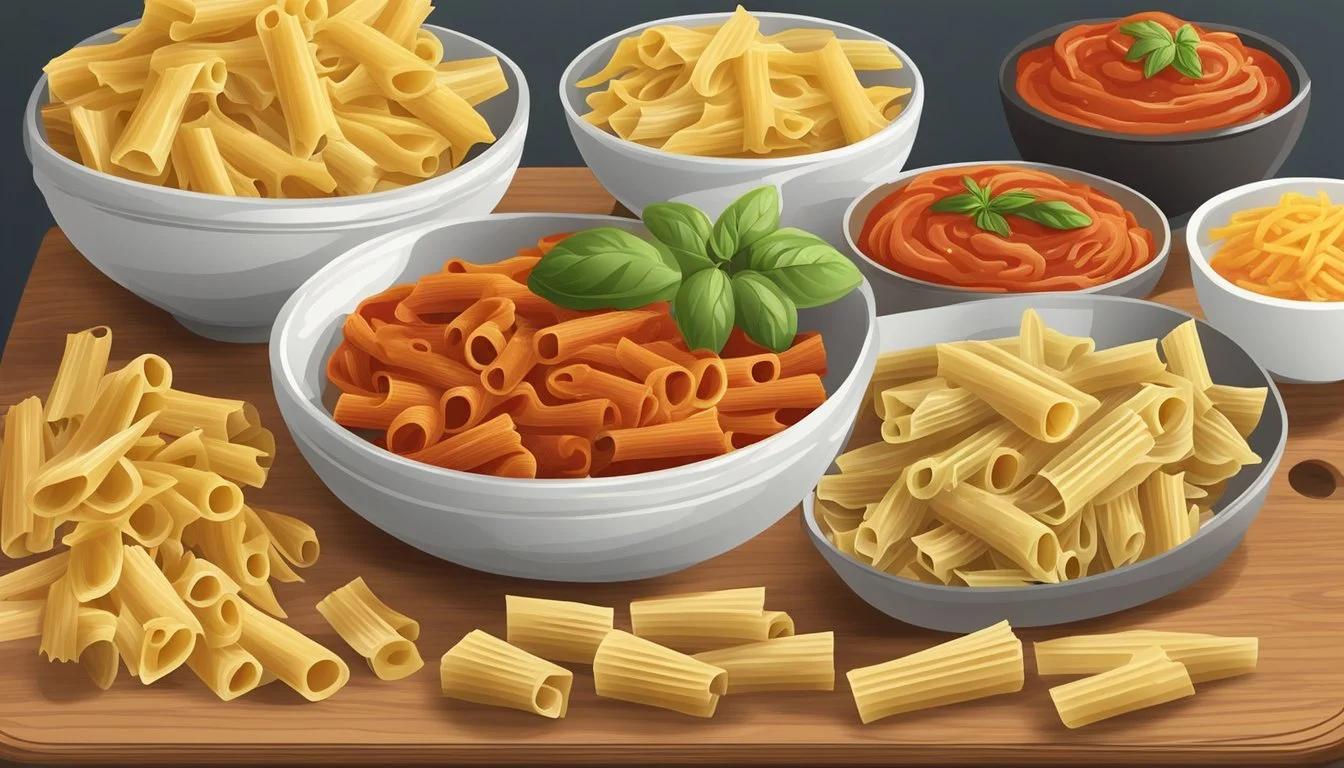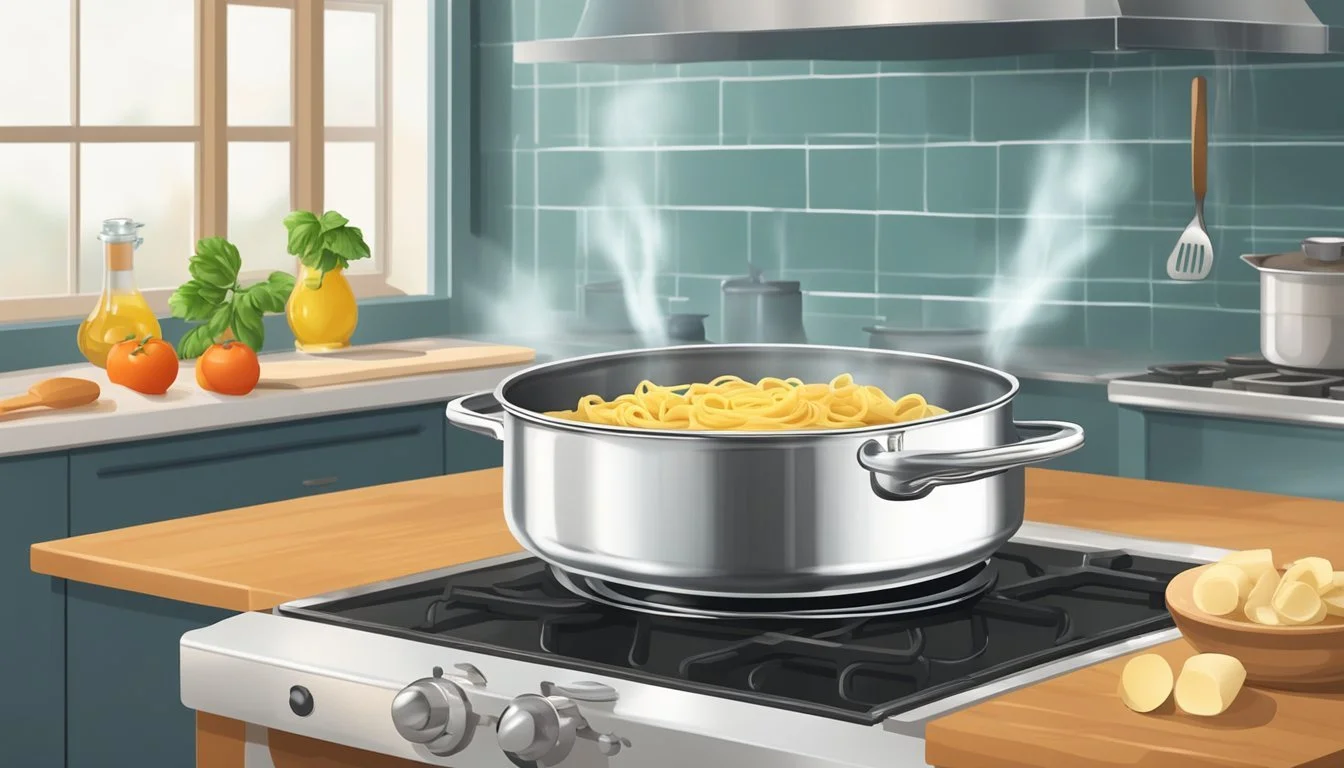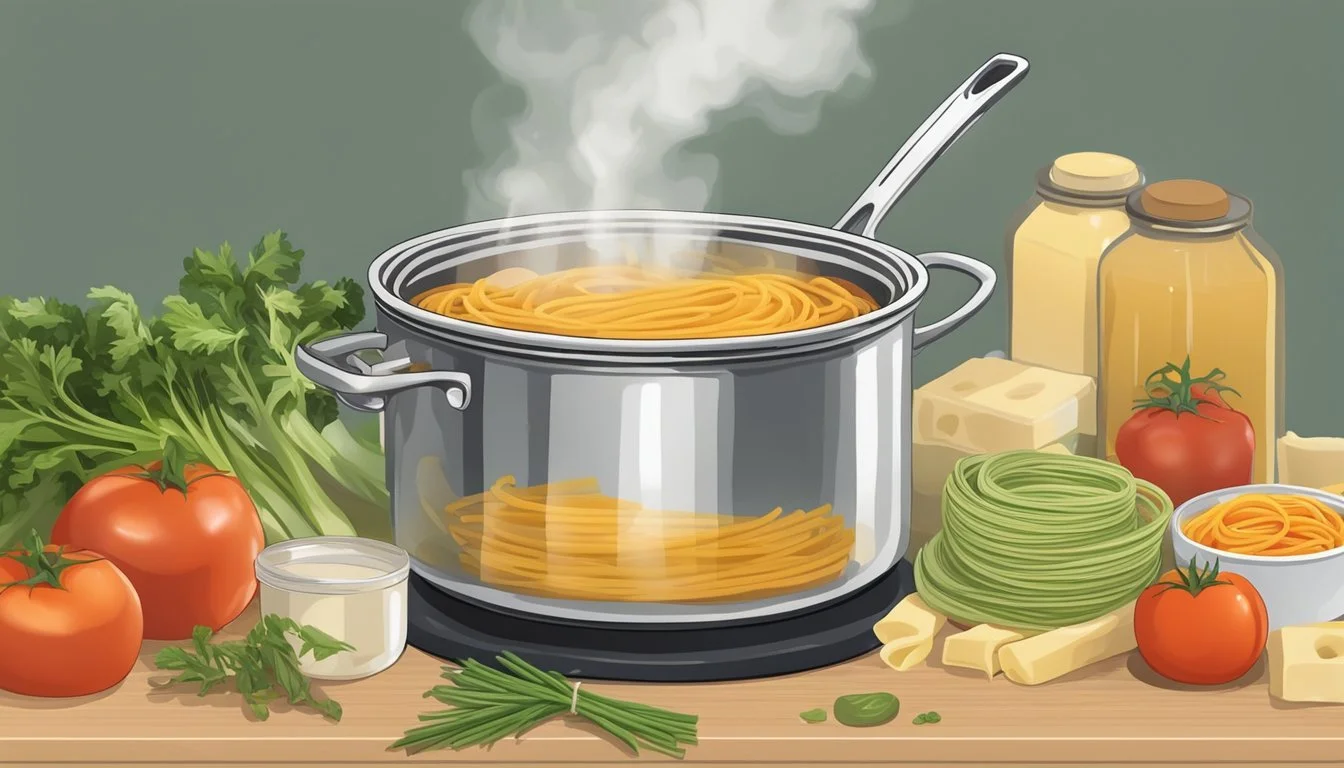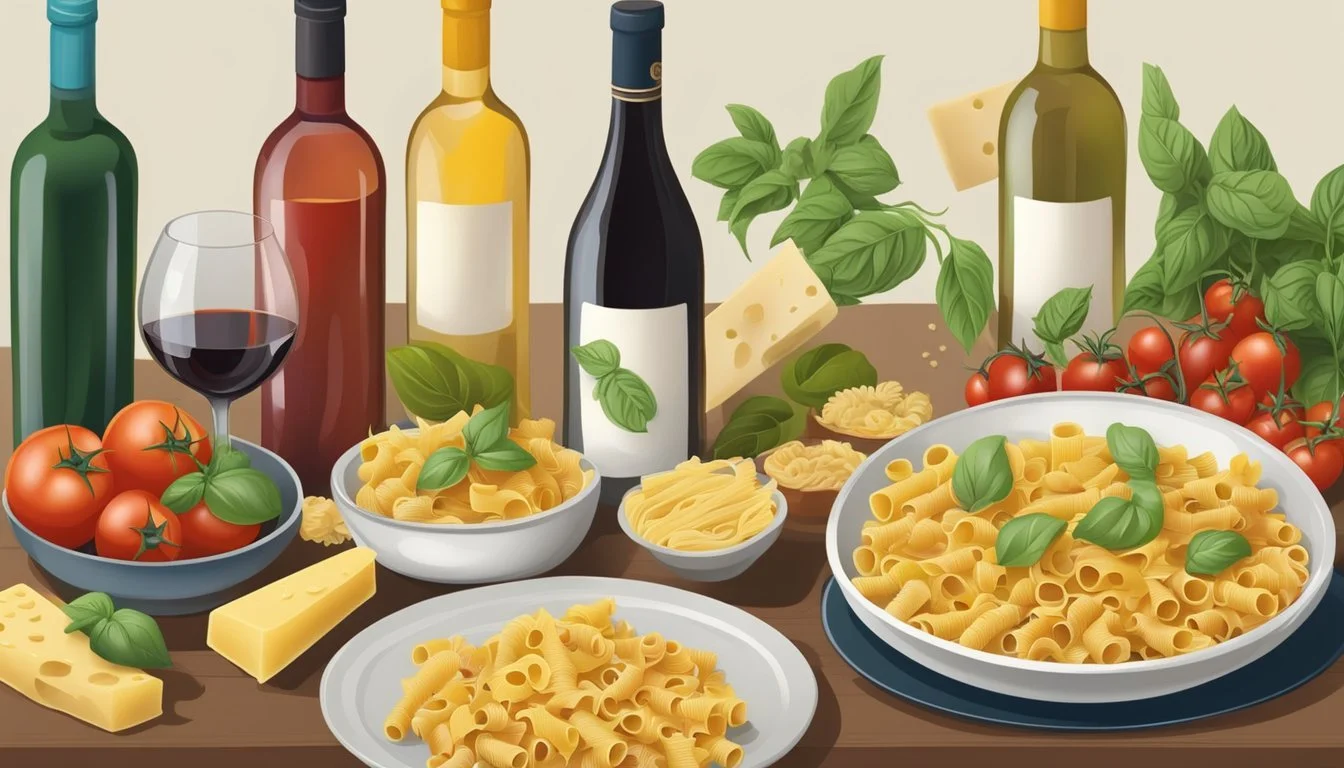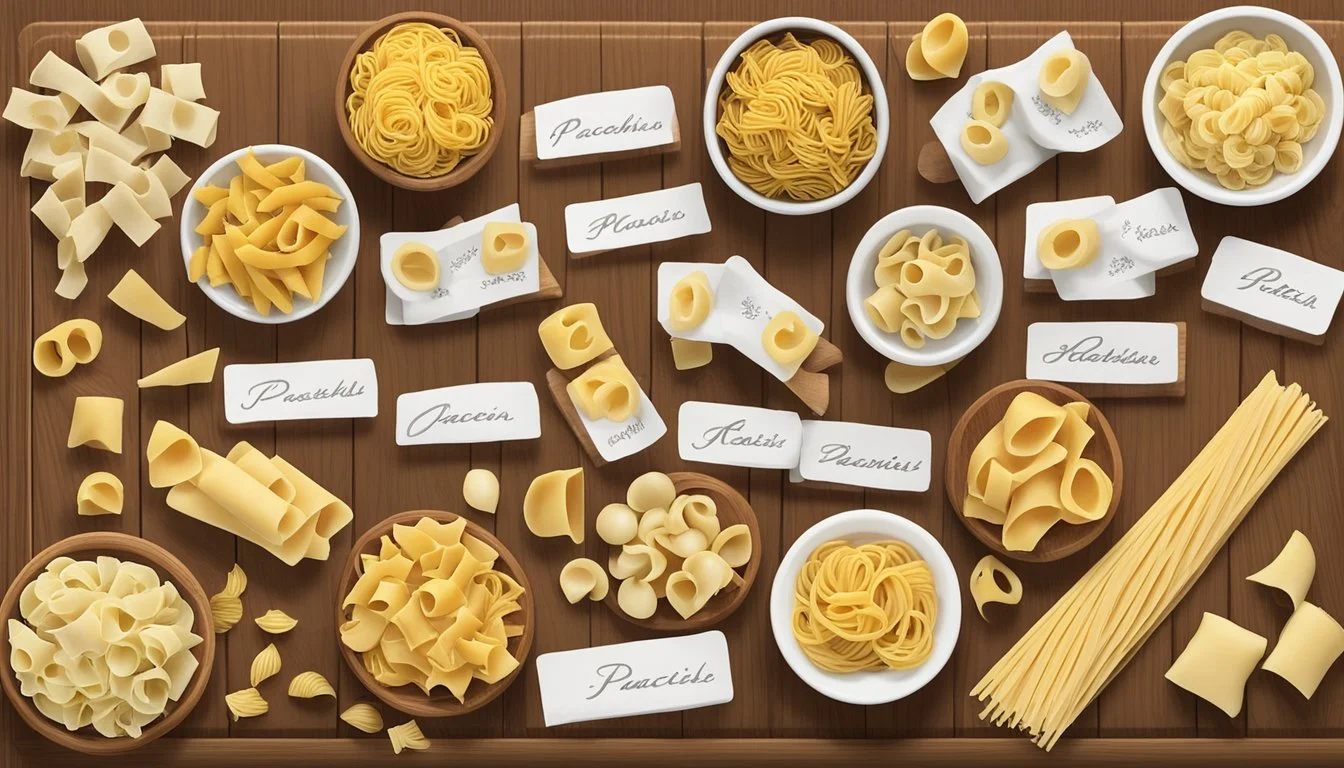Paccheri Pasta Substitutes
Best Alternatives for Your Italian Dishes
Paccheri pasta (What wine goes well with pasta?), with its large tube shape and robust presence on the plate, is a beloved staple in many Italian dishes. Its distinctive size makes it perfect for capturing thick sauces, creating a harmonious balance of pasta and flavor in every bite. Originating from Campania, a region in Southwestern Italy, this pasta is traditionally used in recipes originating from the area and sometimes baked in the oven "al forno."
However, not always is paccheri readily available, prompting chefs and home cooks to seek alternatives that can mimic its unique characteristics. When searching for a substitute, it's essential to consider the pasta's ability to pair with hearty sauces and retain its structure during cooking. Rigatoni and elicoidali emerge as suitable replacements due to their similar size and ridged exterior, which help to hold onto sauces just as effectively.
Selecting an appropriate alternative to paccheri involves evaluating the pasta's texture, cooking qualities, and sauce-pairing ability. While the exact match might not be possible due to paccheri's distinct size, the chosen substitute can still deliver a delightful culinary experience closely resembling that of the original dish. It is about preserving the essence of the meal, ensuring the substitute seamlessly incorporates into traditional recipes without compromising taste and satisfaction.
Understanding Paccheri Pasta
Paccheri pasta, originating from Southern Italy, particularly the Naples region, is a type of Italian pasta that holds a revered place in Neapolitan cuisine. Characteristically large and tube-shaped, these hollow pasta pieces resemble giant rigatoni but bear their distinct appeal and culinary uses.
Composition:
Primary ingredient: Durum wheat semolina
Shape: Large tubes, typically about 1 inch in diameter
Texture: Smooth or ridged
Culinary Versatility: Paccheri is versatile and can be prepared with various sauces or fillings. Given its size, it is ideal for robust flavors and hearty sauces. In Neapolitan tradition, paccheri might be served with seafood or rich meat sauces.
Historical Notes:
Origin: Southern Italy, Campania region
Cultural significance: A reflection of the simplicity and elegance inherent in Italian cuisine.
Preparation Tips:
Boil in generously salted water.
Cook until al dente, usually for approximately 12-15 minutes.
Toss with sauce of choice, consider reserving pasta water to adjust sauce consistency.
In Italian households, paccheri is not just a meal but an embodiment of cultural history and regional pride. Its ability to pair with a variety of ingredients makes it a canvas for culinary artistry, true to the nature of Italian pasta.
Popular Paccheri Pasta Recipes
In the realm of Italian cuisine, Paccheri pasta stands out for its large, tube-like shape that is perfect for rich and hearty sauces. Here are some beloved recipes that showcase the versatility and robustness of Paccheri pasta.
Baked Stuffed Paccheri
Baked Stuffed Paccheri is a dish that transforms the humble pasta into a delectable main course. A traditional recipe includes filling the Paccheri with a creamy ricotta filling mixed with Parmesan and herbs. Post-stuffing, the pasta is typically arranged in a casserole, covered in marinara sauce, and baked until bubbly and golden on top.
Mezzi Paccheri with Mushrooms and Cream
For a comforting and earthy option, Mezzi Paccheri with Mushrooms and Cream reveals the pasta's adaptability. The dish involves mezzi paccheri, a shorter cut of the pasta, and combines it with a selection of mushrooms sautéed to perfection. A dash of cream is added to the mushrooms, forming a rich sauce that coats the pasta evenly and highlights the umami flavors.
Fresh Tuna Ragu with Paccheri
Featuring a coastal twist, a Fresh Tuna Ragu with Paccheri recipe typically involves simmering fresh tuna in a savory tomato sauce infused with garlic and olives. This mixture is then poured over cooked Paccheri, resulting in a dish that shines as a sumptuous and refreshing main course, marrying the boldness of the sea with the heartiness of traditional pasta recipes.
Choosing Substitutes for Paccheri Pasta
When looking for alternatives to paccheri pasta, it's essential to consider size, shape, and texture to ensure a consistent cooking experience and flavor profile. Here are some specific options categorized by similarity and origin.
Similar Italian Varieties
For the closest resemblance in Italian pasta, Rigatoni and Mezzi Paccheri are ideal substitutes. Rigatoni, with its ridged surface, offers an exceptional sauce-holding capability, akin to paccheri. It is slightly narrower but works well in most dishes where paccheri is called for.
Rigatoni: Cylindrical, ridged, typical diameter of 0.8 to 1 inches.
Mezzi Paccheri: Literally 'half paccheri,' resembles shorter versions of the original.
Cannelloni can fill in for paccheri in baked pasta recipes, providing an adequate canvas for stuffing, although it's typically wider and longer.
Non-Italian Alternatives
While traditional Italian pasta varieties are preferred, certain non-Italian pasta shapes can suffice when Italian options are unavailable. For instance, Schiaffoni is an Italian variety that is comparable to some larger, globally available pasta types, notable for their ability to cradle sauces and fillings similar to paccheri.
Schiaffoni: Resembles oversized rigatoni, a suitable stand-in for hearty dishes.
Homemade Pasta Options
Homemade pasta offers flexibility in creating the desired size and texture. For those seeking to replicate paccheri without an extruder, one may roll out the dough and cut it into large, tube-like shapes. The texture of homemade pasta will add a rustic appeal to any dish.
Technique: Roll dough, cut into wide strips, roll into tubes.
Texture: Homemade pasta provides a more tender bite than dried paccheri.
Preparing Your Chosen Substitute
Selecting an alternative to Paccheri pasta requires careful consideration of cooking methods and potential recipe alterations. These steps help ensure that the substitute not only matches the desired consistency but also complements the flavors of the original dish.
Cooking Instructions
When preparing a chosen pasta substitute, it is essential to follow the cooking instructions specific to that type of pasta. If one opts for dried pasta like rigatoni or ziti, which closely match the size and shape of Paccheri, they typically need to be boiled in salted water. Here is a step-by-step guide:
Bring a large pot of water to a boiling point.
Add a pinch of salt to the water to enhance the pasta's flavor.
Gently place the substitute pasta into the boiling water and stir occasionally.
Follow the package’s recommended cooking time—usually between 9 to 13 minutes—to achieve 'al dente' texture.
Before draining, reserve a cup of pasta water to help emulsify and thicken sauces.
For baked dishes, such as "al forno," pre-cook pasta to just under 'al dente' since it will continue to cook in the oven.
Recipe Adjustments
Adapting your recipe is necessary to harmonize with your pasta alternative. Consider the following adjustments:
Extra virgin olive oil: A drizzle can prevent stickiness and add a subtle, fruity flavor to the pasta.
Pasta water: Use sparingly to adjust the sauce's consistency. It can help sauces cling to pasta that lacks the ridges of Paccheri.
Cooking time: Adjust the timing based on the pasta’s thickness and shape; thinner pastas will cook faster.
For baked pasta dishes (What wine goes well with pasta dishes?), the substitute must withstand a second cooking process without becoming too soft.
By carefully cooking your selected pasta and adjusting your recipe accordingly, one can create a dish that is satisfyingly close to the original intended with Paccheri.
Pairings and Sauce Considerations
Choosing the right paccheri pasta substitute involves careful consideration of how it pairs with various sauces, ensuring the alternative pasta complements the sauce's texture and flavor profile.
Sauce Compatibility
When selecting an alternative to paccheri pasta, one should prioritize how the substitute interacts with the sauce. Paccheri is traditionally paired with robust and chunky sauces due to its wide shape and ability to hold onto sauces with hearty ingredients.
Tomato Sauce: Ideal for most pasta shapes, it clings well to ridged tubes like rigatoni or penne.
Cream Sauce: Cream-based sauces like alfredo require a pasta that can support its weight, making fettuccine a suitable choice.
Meat Sauce: Hearty bolognese demands a pasta with grooves, making shapes like tagliatelle or pappardelle excellent substitutes.
Perfect Pairing Ingredients
The composition of a sauce often dictates which pasta shapes pair best. Ingredients such as garlic, basil, or fresh herbs require the pasta to capture their delicate flavors and distribute them evenly.
Basil and Fresh Herbs: Twisted shapes like fusilli or rotini excellently trap fine pieces, optimizing the distribution of these vibrant flavors.
Parmigiano or Parmesan Cheese: Small tubular pastas like ziti ensure that cheeses adhere well, creating a consistent cheesy experience in every bite.
Cheesy Béchamel: A substitute like conchiglie (shells) is perfect for capturing and holding the creamy sauce, complementing the béchamel's texture.
By considering the density and consistency of sauces, cooks can select appropriate pasta substitutes that will uphold the intended gastronomic harmony of paccheri dishes.
Storage and Preservation Tips
When it comes to storing Paccheri pasta, the approach varies significantly between uncooked pasta and leftovers. Proper techniques ensure the quality and longevity of the pasta tubes, whether they're just out of the box or have already made their debut at the dinner table.
Storing Uncooked Pasta
Uncooked Paccheri pasta should be kept in an airtight container to protect it from moisture and pests. This pasta's large tubes can trap air, so it's important to remove as much air as possible before sealing the container. For prolonged shelf life, store the container in a cool, dry place away from any heat sources. The pantry or a kitchen cupboard is typically ideal.
Recommended storage locations:
Pantry: For daily use.
Cupboard: Away from heat and light.
Keeping Leftovers Fresh
Leftover Paccheri pasta is best stored in the refrigerator within two hours of cooking to prevent bacterial growth. One should opt for an airtight container to prevent the pasta from absorbing odors. Additionally, coating the pasta lightly with oil can prevent the tubes from sticking together. If the Paccheri pasta is mixed with sauce, the flavors can further develop when stored correctly.
Storage tips for leftovers:
Fridge: Store for 3-5 days. Ensure the container is sealed tightly.
Freezer: For long-term storage. Freeze in an airtight container for up to 2 months.
Reheat gently, adding a splash of water if the pasta appears dry.
Special Dietary Considerations
When exploring pasta substitutes for special diets, one must consider both the dietary restrictions and nutritional content. The substitutes should aim to replicate the texture and flavor profile of traditional paccheri pasta while adhering to the dietary criteria.
Vegetarian and Vegan Options
For those adhering to vegetarian and vegan diets, the primary concern is ensuring that the pasta substitutes are free from animal products. Options such as pasta made from rice, quinoa or legumes offer a robust alternative to traditional wheat-based pasta. These options are high in plant-based protein and can be a nutritious part of a vegetarian or vegan diet.
Vegetarian Substitute: Quinoa Pasta
Protein: High
Texture: Similar to traditional pasta
Vegan Substitute: Lentil Pasta
Protein: High
Flavor: Nutty, complements bold sauces
Gluten-Free and Allergy Information
Those with gluten intolerance or celiac disease require pasta that is free from gluten, a protein found in wheat, barley, and rye. Gluten-free paccheri pasta can be made from a variety of non-wheat grains or vegetables.
Gluten-Free Substitute: Brown Rice Pasta
Allergen Info: Free from gluten and most common allergens
Note: Slightly chewier texture than wheat pasta<ApplicationUser.ClientIntentValidations.UnknownVariable />, make sure to cook al dente
Additionally, for individuals with allergies, understanding the cross-contamination risks and ingredient lists is critical. Substitutes should be verified to ensure they are produced in a facility that adheres to strict allergen-free protocols.
Allergy-Friendly Substitute: Corn Pasta
Allergen Info: Often gluten-free, always check labels for allergen information
Note: Lighter flavor, pairs well with fresh, vibrant sauces
Enhancing Your Pasta Experience
Choosing the right cheese and garnish can transform a simple pasta dish into a culinary delight. These additions should complement the pasta and sauce for a harmonious flavor profile.
Cheese Selections for Topping
When substituting paccheri pasta, the choice of cheese can significantly impact the dish's flavor and texture. Parmigiano Reggiano, with its granular texture and sharp, complex flavor, provides an excellent finishing touch for robust and hearty sauces. It pairs well with both tomato and cream-based sauces, adding an umami depth to each bite.
For a creamier consistency, ricotta cheese offers a mild, slightly sweet flavor which blends seamlessly into lighter sauces or can be used as a stuffing. Its fluffy texture introduces a pleasant contrast to the denser pasta substitutes.
Lastly, mozzarella cheese, known for its superb melting qualities, works wonders on baked pasta dishes. The cheese creates a stretchy, gooey layer that can encapsulate the bold shapes of the substitutes, such as rigatoni or mezzi pasta. Utilizing either fresh mozzarella or its drier counterpart will depend on the desired moisture level in the dish.
Utilizing Fresh Garnishes
In addition to cheese, fresh garnishes play a vital role in elevating the overall sensory experience of a pasta dish. Fresh basil leaves not only add a vibrant pop of color but also impart a sweet, peppery flavor that can cut through the richness of the cheeses. Tearing the leaves rather than chopping preserves the delicate oils and prevents bruising, ensuring the freshest taste and aroma.
Incorporating fresh herbs and garnishes properly can make a significant difference:
Chop basil leaves just before serving to maintain freshness.
Layer basil on top of the cheese for baked dishes to infuse the aroma without burning the leaves.
Garnish at the end of cooking for optimal impact.
By paying attention to these details, diners can enhance the overall enjoyment of their substitute pasta, creating a dining experience that is satisfying to both the palate and the eye.
Creating a Complete Meal
When serving Paccheri pasta as the main course, it is essential to consider how side dishes can enhance the overall dining experience. A proper selection can turn the pasta dish into a balanced and satisfying meal.
Complementary Side Dishes
Salads: A fresh salad serves as the perfect counterpart to the hearty texture of Paccheri. The crispiness of the greens can provide a refreshing contrast. A classic choice would be an Italian mixed greens salad with a simple dressing of olive oil and balsamic vinegar.
Grain Salads: A cold quinoa or barley salad seasoned with herbs can be a light yet robust pairing.
Roasted Vegetables: Vegetables like asparagus, bell peppers, or Brussels sprouts, roasted with olive oil and a hint of garlic, complement the rich sauce normally accompanying Paccheri.
Building a Balanced Course
The principle of crafting a balanced course lies in combining the Paccheri pasta's satiety with side elements that add varying textures and contrasting flavors.
Main Course Considerations:
Protein: Incorporate a protein such as grilled chicken breast or seared fish to sit alongside or atop the Paccheri, lending substance to the meal.
Texture: Ensure the presence of an element with crunch, perhaps a small side of garlic crostini or toasted nuts sprinkled over the salad.
Nutritional Balance:
Fiber: The salad or vegetable sides introduce necessary fiber for digestive balance.
Carbohydrates: Paccheri pasta itself is the main source of carbohydrates, so keep additional carb-heavy foods minimal.
By carefully selecting side dishes that add variety in flavor and texture, one can turn a plate of Paccheri pasta into a complete and balanced meal that satisfies the palate and the body's nutritional needs.
Pasta Preparation Techniques
To excel in the art of pasta preparation, particularly with substitutes for Paccheri, one must master the techniques of properly boiling pasta and creating perfect fillings.
Expert Tips for Boiling Pasta
When boiling pasta, timing and water quality are key. Chefs recommend using a large pot with plenty of water — about 4 quarts of water to every pound of pasta — to allow the pasta enough space to move freely during cooking, thus preventing sticking. Water should be as salty as the sea, a critical step for flavor. It's important to stir the pasta with a slotted spoon a few times throughout cooking to ensure even cooking. For substitutes like Rigatoni or Cannelloni, which can replace Paccheri, following the package instructions for al dente pasta is crucial, as they typically have similar cooking times.
Water-to-Pasta Ratio: 4 quarts of water per 1 pound of pasta
Saltiness: Season water until it's as salty as seawater
Stirring Technique: Use a slotted spoon to gently stir
Once the pasta is cooked, one can utilize a cheese grater to add a touch of freshly grated cheese to the dish before serving. This not only enhances flavor but also adds a professional touch.
Secrets to Perfect Pasta Fillings
For stuffed pasta, achieving the perfect filling consistency is vital. A pastry bag equipped with a round pastry tip is often used for precision in filling tubular pasta substitutes for Paccheri, like Cannelloni. Fillings typically include a mixture of cheeses, such as ricotta or mozzarella, combined with herbs and sometimes proteins like ground meat or spinach. The consistency should be neither too dry nor too runny to ensure it stays within the pasta during cooking.
When filling pasta, deflate any air pockets by giving the pasta a gentle slap against the work surface. Here’s a breakdown for the process:
Mix filling ingredients until smooth and homogenous.
Fill a pastry bag fitted with a round tip with the pasta filling.
Pipe the filling into the pasta evenly, avoiding overfilling.
Eliminate air pockets with a gentle slap.
Mastering these techniques ensures that whether one stays true to Paccheri or uses a substitute, the pasta will be prepared with the expertise of a seasoned chef.
Food Pairing and Hosting Ideas
Properly pairing pasta with the right wine and beverages can elevate a dining experience. When hosting an event, it's equally important to ensure that serving suggestions are considered to complement the robust Italian flavors often associated with dishes like paccheri pasta.
Wine and Beverage Matches
When substituting paccheri, consider the Italian tradition of pairing pasta with wine that complements the dish's flavors. Bold red wines, such as Chianti or Barolo, have the structure and depth to match with tomato-based sauces commonly served with paccheri. For cream or cheese sauces, a full-bodied white, like a Chardonnay, may be a better match due to its creaminess.
Sauce Type Wine Recommendation Non-Alcoholic Option Tomato-based Chianti, Barolo Sparkling Grape Juice Cream/cheese-based Chardonnay Herbal Iced Tea
In addition to wine, incorporate aromatics such as basil and oregano in both the dish and surrounding ambiance to highlight the Italian flavor profile.
Serving Suggestions for Gatherings
For gatherings, the host should present the pasta with a focus on communal dining. Large platters or a family-style setting allow guests to immerse themselves in the shared experience. Ingredients should embody the fresh, bold tastes of Italy – think sun-dried tomatoes, fresh basil, and a grating of Parmesan cheese.
Appetizers: Begin with light antipasti like bruschetta or caprese salad to introduce guests to the Italian palate.
Main Course: Serve the substituted paccheri with a variety of sauces. Guests can then select the combination that best fits their preferences.
Shopping Guide for Pasta Lovers
When shopping for the perfect pasta, lovers of Italian cuisine look for quality and authenticity. Identifying genuine Italian brands and knowing where to procure specialty pasta types are paramount in replicating an original Italian dining experience.
High-Quality Italian Brands
Italian pasta brands hold prestige in the culinary world for their adherence to traditional methods and use of high-grade ingredients. Discerning shoppers should look for brands like Di Martino and Garofalo, which are renowned for their premium pasta made from top-quality durum wheat and pristine water. Gentile is celebrated for its artisanal methods, such as using bronze dies to shape the pasta and slow drying processes that enhance texture and flavor. Afeltra and Pastificio dei Campi are other acclaimed brands, with the latter being praised for its traceability system, allowing consumers to track their pasta's production journey. For organic pasta lovers, Girolomoni is a go-to brand for its commitment to organic farming and sustainability.
Where to Find Specialty Pastas
Shoppers seeking specialty pasta types, including paccheri, often turn to Italian specialty shops as their primary source. These shops take pride in their extensive selection that often includes rare and imported varieties, making them ideal for finding substitutes for paccheri or other unique shapes. Across the European market, and increasingly in international territories, these specialty stores provide an authentic shopping experience akin to what one might find in Italy. Many also offer online shopping options, catering to those who might not have a local specialty shop nearby. For those in search of paccheri or its substitutes, these establishments usually stock an assortment of robust tubes that can be used in various Italian recipes.
Advanced Cooking Techniques for Pasta Dishes
These techniques take pasta dishes beyond the basics, appealing to those who want to elevate their culinary craft and surprise their guests with new structures of beloved flavors.
Baked Pasta Mastery
Choosing the Right Pasta: Pasta with ridges like paccheri is ideal for baked dishes because the ridges catch and hold sauces, resulting in a flavorful bite. It's essential to cook it to al dente to prevent it from becoming mushy during baking.
Layering Flavors: Constructing a baked pasta dish involves more than simply mixing pasta with sauce. Chefs recommend layering ingredients to create a depth of flavor. Begin with a base of seasoned ricotta and follow with alternating layers of pasta, sauce, and cheese:
Base layer: Seasoned ricotta
Second layer: Al dente paccheri
Cooked to al dente
Third layer: Bechamel or tomato-based sauce
Fourth layer: Mozzarella or a cheese blend
Baking Time and Temperature: Preheat the oven to 375°F and bake until the top is golden brown, signaling a perfectly crispy cheese top.
Creating Signature Pasta Cakes
Structural Integrity: Pasta cakes require a pasta that can stand up to layering and slicing. Paccheri's large size and robust structure make it an outstanding choice.
Filling and Assembly: Just like constructing a traditional cake, chefs should consider balancing moisture and texture in a pasta cake. They can achieve this by:
Cooking paccheri until just before al dente.
Filling each tube with a mixture of cheese, herbs, or a flavorful meat ragu.
Stacking the filled tubes vertically in a springform pan for a visually stunning pasta cake.
Presentation: Once baked and rested, the pasta cake should be carefully released from the springform and served in wedges, showcasing the intricate layered interior.
Exploring Regional Italian Pasta
In Italy, each region takes pride in creating unique pasta shapes and dishes that reflect their local traditions and tastes. Campania is well-known for its pasta, while Italian pasta, in general, showcases a rich tapestry of diversity.
Flavors of Campania
In Campania, paccheri stand out as a signature pasta. Originating from Gragnano, a town acclaimed for its pasta production due to its perfect climatic conditions, paccheri are large, tube-shaped pasta with a robust texture. The variants paccheri lisce (smooth) and paccheri rigati (ridged) offer different mouthfeels and sauce-capturing abilities. This versatile pasta absorbs flavors beautifully, making it ideal for the region's rich, hearty sauces that often include seafood, tomatoes, and cheeses like mozzarella.
Diversity in Italian Pasta
Italian pasta is celebrated for its astonishing variety. Pasta shapes and textures vary significantly from region to region, each suited to a particular set of ingredients and sauces. Whether it's the thin, delicate strands of pasta from the north or the rugged, hearty shapes from the south, each type serves as a testament to Italy's regional culinary diversity. Campania's contribution of paccheri epitomizes this regional specialization, offering a distinct way to enjoy the flavors of the area.


